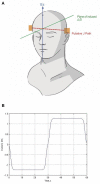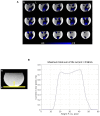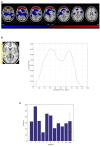Inconsistencies in mapping current distribution in transcranial direct current stimulation
- PMID: 37555148
- PMCID: PMC10406311
- DOI: 10.3389/fnimg.2022.1069500
Inconsistencies in mapping current distribution in transcranial direct current stimulation
Abstract
Introduction: tDCS is a non-invasive neuromodulation technique that has been widely studied both as a therapy for neuropsychiatric diseases and for cognitive enhancement. However, recent meta-analyses have reported significant inconsistencies amongst tDCS studies. Enhancing empirical understanding of current flow in the brain may help elucidate some of these inconsistencies.
Methods: We investigated tDCS-induced current distribution by injecting a low frequency current waveform in a phantom and in vivo. MR phase images were collected during the stimulation and a time-series analysis was used to reconstruct the magnetic field. A current distribution map was derived from the field map using Ampere's law.
Results: The current distribution map in the phantom showed a clear path of current flow between the two electrodes, with more than 75% of the injected current accounted for. However, in brain, the results did evidence a current path between the two target electrodes but only some portion ( 25%) of injected current reached the cortex demonstrating that a significant fraction of the current is bypassing the brain and traveling from one electrode to the other external to the brain, probably due to conductivity differences in brain tissue types. Substantial inter-subject and intra-subject (across consecutive scans) variability in current distribution maps were also observed in human but not in phantom scans.
Discussions: An in-vivo current mapping technique proposed in this study demonstrated that much of the injected current in tDCS was not accounted for in human brain and deviated to the edge of the brain. These findings would have ramifications in the use of tDCS as a neuromodulator and may help explain some of the inconsistencies reported in other studies.
Keywords: current mapping; functional magnetic resonance imaging; non-invasive neuromodulation; transcranial direct current stimulation; transcranial electrical stimulation.
Copyright © 2023 Jwa, Goodman and Glover.
Conflict of interest statement
The authors declare that the research was conducted in the absence of any commercial or financial relationships that could be construed as a potential conflict of interest.
Figures






Similar articles
-
In-vivo Imaging of Magnetic Fields Induced by Transcranial Direct Current Stimulation (tDCS) in Human Brain using MRI.Sci Rep. 2016 Oct 4;6:34385. doi: 10.1038/srep34385. Sci Rep. 2016. PMID: 27698358 Free PMC article. Clinical Trial.
-
Anisotropic conductivity tensor imaging for transcranial direct current stimulation (tDCS) using magnetic resonance diffusion tensor imaging (MR-DTI).PLoS One. 2018 May 15;13(5):e0197063. doi: 10.1371/journal.pone.0197063. eCollection 2018. PLoS One. 2018. PMID: 29763453 Free PMC article.
-
Inter-Individual Variation during Transcranial Direct Current Stimulation and Normalization of Dose Using MRI-Derived Computational Models.Front Psychiatry. 2012 Oct 22;3:91. doi: 10.3389/fpsyt.2012.00091. eCollection 2012. Front Psychiatry. 2012. PMID: 23097644 Free PMC article.
-
Effects of neuromodulation on cognitive performance in individuals exhibiting addictive behaviors: A systematic review.Drug Alcohol Depend. 2018 Nov 1;192:338-351. doi: 10.1016/j.drugalcdep.2018.08.018. Epub 2018 Oct 3. Drug Alcohol Depend. 2018. PMID: 30317162 Free PMC article.
-
Incomplete evidence that increasing current intensity of tDCS boosts outcomes.Brain Stimul. 2018 Mar-Apr;11(2):310-321. doi: 10.1016/j.brs.2017.12.002. Epub 2017 Dec 13. Brain Stimul. 2018. PMID: 29258808 Free PMC article. Review.
Cited by
-
Transcranial direct current stimulation for Parkinson's disease: systematic review and meta-analysis of motor and cognitive effects.NPJ Parkinsons Dis. 2024 Nov 6;10(1):214. doi: 10.1038/s41531-024-00821-z. NPJ Parkinsons Dis. 2024. PMID: 39505889 Free PMC article.
References
-
- Arora Y., Walia P., Hayashibe M., Muthalib M., Chowdhury S. R., Perrey S., et al. . (2021). Grey-box modeling and hypothesis testing of functional near-infrared spectroscopy-based cerebrovascular reactivity to anodal high-definition tDCS in healthy humans. PLoS Comput. Biol. 17, e1009386. 10.1371/journal.pcbi.1009386 - DOI - PMC - PubMed
LinkOut - more resources
Full Text Sources

